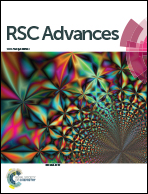Rutile TiO2 mesocrystallines with aggregated nanorod clusters: extremely rapid self-reaction of the single source and enhanced dye-sensitized solar cell performance†
Abstract
This paper reports a simple and environmentally friendly approach for the synthesis of rutile TiO2 mesocrystals (RTM) composed of single crystal aggregated nanorod clusters. It is a hydrothermal method involving titanium(III) chloride as the only reactant. The resulting one-dimensional rutile nanorods can easily assemble into three-dimensional hierarchical architectures without any surfactants or additives. By selecting appropriate experimental conditions, such as reaction time and ripening temperature, we can easily manipulate the RTM microstructure. Detailed experiments suggest that the growth of the RTM is spontaneous and an extremely rapid self-reaction of titanium(III) chloride, which is controlled by the thermodynamics process. Furthermore, the composites photoanode was fabricated by hybridizing RTM and TiO2 nanoparticles (Degussa-P25 powder) for use in dye-sensitized solar cells (DSSCs). The composite photoanode-based DSSC possesses superior performance to TiO2 nanoparticle cells. A high light-to-electricity conversion yield of 7.3% for composite photoanodes was achieved, significantly higher than that of TiO2 nanoparticle photoanodes with a similar thickness (5.45%). This result can be attributed to their synergistic effect of high crystallinity, light scattering and fast charge transfer capability.


 Please wait while we load your content...
Please wait while we load your content...